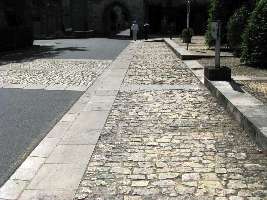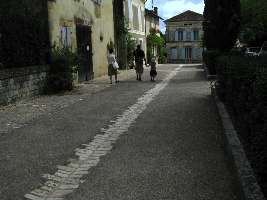Back to Don's Maps
Back to Venus figures from the Stone Age
The Venus of Monpazier, carved in limonite
The statuette of Monpazier was collected in 1970 on the surface of a freshly ploughed field. It has a well drawn vulva. The pronounced buttocks and the projecting belly gave it the name Punchinello, but some see in it a woman about to give birth. Punchinello is the short fat buffoon or clown in an Italian puppet show. Carved in limonite, a yellowish brown ore of iron.
Age: 30 000 - 20 000 BP (?)

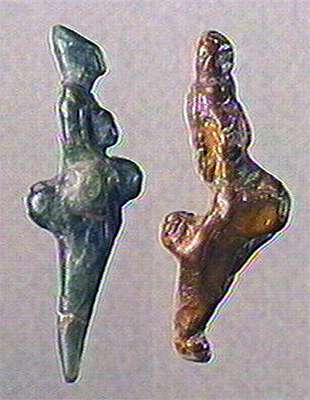
The venus of Monpazier, a steatopygous (having large buttocks) figure, which condition in females has been conjectured as being once more prevalent in Europe than today, shown for comparison with the Grimaldi venus of le Polichinelle, the greenish figure on the left.
It is from the Gravettian period, and was discovered in a ploughed field by E. Cerou of Montpazier. Some flint cores were found nearby.
The composition of the piece is of limonite, with some quartz and yellowish brown clay. The ironstone rock of which it is made is common in the area.
With a length of 56 mm, width 16 mm and thickness 14 mm, this statue is one of the smallest of those assigned to the Gravettian. The head, slightly subspherical and asymmetrical, is, like that of many similar venuses, relatively small. The eyes can be considered as rendered by oval cups, the left one being bigger, and situated a little higher on the face than the right. Instead of a nose, a natural depression was carefully polished.
Text: Translated and adapted from http://www.culture.gouv.fr/
Photo: http://www.culture.gouv.fr/
Catalog: MAN83303

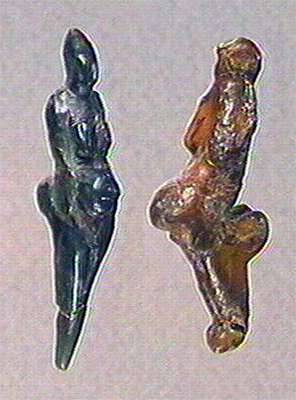
On the back of the head are a natural deep cavity and a natural cupule on top of the skull. The thick neck is poorly defined. The narrow waist is of normal proportions, but the arms are missing. The breasts, sagging and large, are rather flat, separated by a groove which defines their lower extent and continues to the back of the figure. The spherical belly is large and projected forward and is bounded by a wide and shallow groove.
The vulva is extraordinary, with a height equal to that of the buttocks; disproportionate, it is nevertheless realistic, with a wide slit, deep, and surrounded by labia in high relief. The back is not working, the camber of the kidneys and the protrusion of the buttocks are even more pronounced than in the Tursac and Sireuil venuses. The gluteal hemispheres are separated by a deep groove. The legs, relatively short and poorly formed, do not distinguish between the thigh and the lower leg, but are separated from each other on the ventral surface by a path that goes from the vulva to the feet
Lers membres inférieurs, relativement courts et mal formés, ne permettant pas de distinguer la cuisse de la jambe, mais sont séparés l'un de l'autre, sur la face ventrale, par un sillon qui va de la vulve jusqu'aux pieds
Mesures
Text: Translated and adapted from http://www.culture.gouv.fr/
Photo: http://www.culture.gouv.fr/



The Venus of Monpazier.
Photo: © RMN-Grand Palais / Jean-Gilles Berizzi
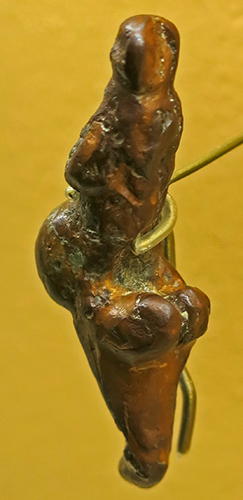
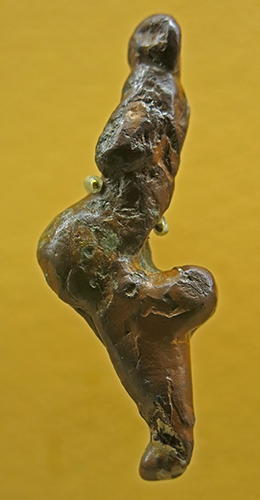
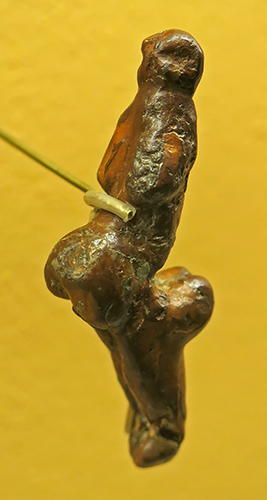
Venus of Monpazier.
Photo: Don Hitchcock 2014
Source: Facsimile, Musée d'Archeologie Nationale et Domaine, St-Germain-en-Laye

Pulcinella, often called Punch or Punchinello in English, Polichinelle in French, is a classical character that originated in the commedia dell’arte of the 17th century and became a stock character in Neapolitan puppetry.
Photo and text above: http://yamino.tumblr.com/post/4210086884/pulcinella-italian
The Venus of Monpazier and the Venus of Polichinelle have both been compared to this character.


Monsieur Elisée Cérou, président du Groupe Archéologique de Monpazier
M. Cérou volunteered regularly for supervision in the Museum of Monpazier, and I was privileged to make his acquaintance. He is the discoverer, in 1970, of the Venus of Monpazier in a ploughed field, and the co-author of the paper above.
M. Cérou passed away in 2017 in his 88th year, mourned by his many relatives and friends.
Photo: Don Hitchcock 2008
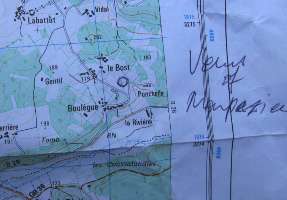
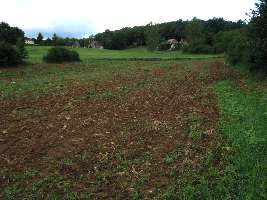
M. Cérou was kind enough to mark the location of the find on my map (as well as some other very important sites), and I was able to locate the site (seen in the photograph on the right), for which I was very grateful.
M. Cérou is a true gentleman, a pleasure to meet and talk to, and has discovered much about the archaeology of the Monpazier area, which he has been doing for most of his life, since he was a young boy.
I was also delighted to find that the field had been freshly ploughed yet again when I found it, but although I looked carefully, I could not find any venuses!
Photo: Don Hitchcock 2008
Monpazier itself is a delightful medieval city. I love the way the cobblestones have been laid, with rectangles of sawn stone defining their borders. This is an excellent treatment.
Note the gutter running down the middle of the road, done in stone, and the pedestrian crossing done in cobble stones. In Germany I saw a zebra crossing done in pure black and pure white stone - totally maintenance free, and a delight to the eye!
Photo: Don Hitchcock 2008
La statuette féminine de Monpazier (Dordogne)
The statuette was found by Monsieur Elisée Cérou, jeweller of Monpazier, in a ploughed field, taken as a clod of earth during the collection of flint at a surface station located in Canton of Monpazier in April 1970. On the 19th July of the same year, G. Astruc, M. Carriere, J. Clottes and G. Maury, entering by chance the shop of E. Cérou, examined his collection and realised the importance of this artefact.
M. Bordes, Directeur de la Circonscription Préhistorique was immediately alerted to the discovery. As a result of further investigations, the figurine was assigned to the Final Perigordian of the Western Europe Paleolithic, along with similar venuses of Laussel, Lespugue, Pataud and Tursac.
(The distinguished archaeologist James R. Sackett has written an interesting short Biography of François Bordes which may be of interest to readers - Don )

The statue of Monpazier, three-quarter view.
If the statuette were a fake, it would be the work of a forger who not only possessed great skill, but would be sufficiently aware of the character of prehistoric statues to sculpt a figurine, both similar to one of those from Grimaldi, (the Venus of Polichinelle - Don) but which differs, however, by other characteristics such as the brevity of the lower limbs, and no arms, that we find on other statuettes from Russia to the Pyrenees, or by original elements (sex, feet, back of legs) that do not seem implausible.
The statue, intact at its discovery, unfortunately suffered two accidents in restoring it, according to an old and unfortunate tradition (Brassempouy, Lespugue etc.). During initial washing it slipped from the hands of its discoverer and broke into 3 pieces (the left side of the head was detached, and the figure was fractured at the waist). Fortunately, the breaks being clean and without crumbling, the broken pieces could be immediately reseated with wax.
Then, during its examination in the laboratory of Dr. Pales, it slipped from his grasp, and one part of the foot was pulverised. All the fragments recovered, as tiny they were, were picked up with great care by Dr. Pales, who immediately reattached with wax the missing parts of the foot, based on the many photographs already taken.
Photo: Clottes et Cérou(1970)
This argument, however important it may be, is not decisive, and we submitted our statuette to a thorough examination by binocular microscope (X18) which found that all the visible marks of manufacture (on the neck, vulva, the separations between the breasts and the legs) had exactly the same patina as the most exposed parts.
Indeed, the second accident that the statuette had revealed the structure and the internal color of the material, which we would never have decided to research in that way.
The centre of the stone, at the level of the ankle and foot, has emerged as a hard material but with finely spongy appearance, with a very clearly marked bright yellow edge on the much darker color of the superficially highly weathered exterior of the figurine.
Examination of the environment where the discovery was made and the study of lithic tools collected at the station are obviously of great interest.
This station covers a large surface area and its exploration has just begun. The inventor has found hundreds of blades and flakes, but tools and retouched pieces are rare. However, we can assign them to three periods:
1. Mousterian (small bifaces, scrapers)
2. Perigordian
3. Recent periods (polished stone axes, parts of arrows)
The Perigordian is unquestionably attested to by six entirely conventional prismatic cores, for the most elongated and all on the double-strike plan. They have a characteristic bright yellow patina which we find on a lot of flakes and blades. Two of these cores were collected a few metres away from the place where the statuette was found during an inspection visit. In summary, it is not possible, as for so many of the predecessors, to testify without reserve to the authenticity of the Monpazier figurine, but we have not found any indication that allows for doubt.
This long preamble is intended to bring to life the facts as we see them, and also to share elements favourable or unfavourable to the validity of a document which we would like to be spared the controversies that many of its predecessors have been subjected to.
Description
Colour and material: The dominant colour of the statuette is a chocolate brown, but in places large yellow patches reflect the complexity of the material. These occur on: front - right breast, right hip and thigh; back - legs, head and concavities back; profile - right side abdomen and left thigh.
The analysis we have made has revealed that the material is a substance formed by a natural association of iron hydroxide (limonite), of quartz, and probably clay, presumably from a local ironstone outcrop. Density, 2.77 (part glued) exceeds that of quartz and clay and is less than that of pure limonite, which has a density of 3.6 - 4.0.
The choice of this material was undoubtedly because it already had shape similar to the subject to be represented. This is the first Venus, to our knowledge, carved in this material, although the Ostrava-Petřkovice Venus from the Gravettian site in Moravia used hematite, also an iron ore (Gaudron 1956).
General appearance
Viewed from the front, it is standing like almost all Western European female statuettes (Delporte, 1965). It seems relatively thin and is in an elongated rectangle (55 mm X 14 mm maximum).
The most obvious characteristics of the statue are the eyes, the heavy and drooping breasts, the prominent belly, enlarged vulva, lack of arms, legs very short and attached, and the presence of feet.
In profile, it is highly curved, which increases the prominence of both belly and buttocks, and the feet are well marked. At the back, with the exception of the buttocks, it presents a much more crude aspect: the natural surface has been poorly reworked, and it has deep natural depressions. The separation between the legs is not indicated. Therefore, it was intended to be viewed from the front, like most female figurines, except those of Sireuil and Tursac (Delporte, 1959 b).
Detailed Description
The upright head is slightly smaller than normal anatomical proportions ( 1/8 instead of 1/7 of the total height of the body). It is nearly round, barely wider than high, slightly asymmetrical, with the right hemisphere (anatomical sense of the word) lower than its counterpart. We find the same asymmetry in the eye position, represented by oval cupules in the bottom of which we can still distinguish the fine horizontal grooves of the instrument that was used to dig them. These cupules form a peak and taper toward the nose. The left eye, which is significantly larger than the right, is shifted to the left and is higher than the right eye, which almost reached the centre of the face. The upper edges of the two cupules or wells appear much better made than the lower edges. In the position of the nose, a central depression seems part of the original limonite pebble, but the edges were carefully polished so that the eyes appear to possess large orbits.
Natural features
The posterior part of the head is divided over its entire height by a wide and deep natural cavity, predating the construction of the statue. We also noted a natural cupule on the top of the head, on the right side, and on the same side, approximately in the position of the ear, a superficial alteration of the surface, with a weathering patina like the rest of the piece, but showing no sign of tool marks.
Finally, a vacuolated, sponge-like zone, barely visible under the left eye, found also on the breast and part of the stomach.
The neck, which is thick and only slightly differentiated from the rest of the figurine, is, however, clearly marked, including at the back of the figurine, where the narrow groove delineating the back of the neck is significantly lower than on the side, a difference of nearly 2 mm. This lack of regularity also appears on the front: the top line of the neck is not horizontal, but drops down to the right.

Venus of Monpazier, front view.
The sagging breasts have been shaped, with an obvious wish for symmetry, from a largely natural form, vacuoles already noted on the left breast corresponding to an alteration of the surface of the stone chosen for making the statuette. On the right breast, a long natural depression, which gives it a somewhat flattened appearance, is bordered by a thin ridge located at approximately the same level. The artist thus merely widened the gap between the breasts to regularise the outsides and the base for their shapely curve.
Examination with the binocular microscope shows, like fingerprints in plasticine, that on two occasions before the vertical lines were used to widen the separation between the breasts, the artist cut clearly visible horizontal grooves on the top of the thoracic-abdominal region, showing anticipation of the shaping still to be done. It would seem that the artist, at least with regard to this part of the body, has carved the main features before focusing on the details.

Venus of Monpazier, left profile.
Viewed from the side, the lower left breast is outlined by a groove that continues to the back. It is the same for the right breast, but the continuity is interrupted posteriorly by a natural depression that cuts across the back of the statue diagonally, from the upper third of the right breast to the left buttock. This depression measures 21 mm x 4 mm and about 2 mm deep at the waist, where it widens and affects in part the right side of the right buttock.
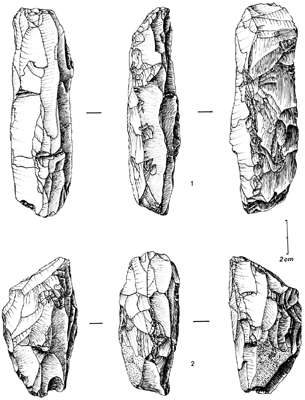
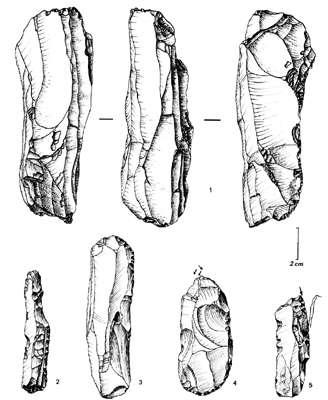
(left)
1 and 2 - Prismatic cores found at the site of the Monpazier Venus.
(right)
1 - Prismatic core
2, 3 - grattoirs, scrapers on a blade.
4 - burin-grattoir, a scraper with a burin (or chisel, or graver, or engraver) on one end.
5 - burin d'angle, an angled burin or graver. Burins were used for engraving or carving wood or bone.
Little alteration has been made to the back of the piece. Some striations and facets indicate that the artist was content to round off this part of the statue and remove a few bumps, but the natural depression already cited, and several others in the centre of the back and on the left side, makes us think that the original shape of the pebble has been largely retained.
The general appearance of the cervicodorsal spine (spine in the region of the neck and thorax - Don) is rounded, with a marked thickening on the scapula (shoulderblade) the figurine has "a round back" or "hunched shoulders". In the lateral view, the body is very curved, which can be explained by the prominence of the abdomen, but mainly due to the depression which gave its special aspect to the statuette.
The Venus of Monpazier
This is a natural pebble of quartz-limonite oddly shaped, transformed into a female figure (fig. 33). Like the statue of Milandes, this object was found in a cultivated field. Gravettian dating has been assigned to the lithic industry associated with it. Apart from being also made from a pebble, the only similarity with the statue of Milandes is the posture, with an arched back and with belly thrust forward. As with the Venus of Sireuil, that of Monpazier is much more elaborate, with breasts, legs and vulva clearly indicated. At 55 mm high, it is a little smaller than the other statuettes presented here.
We looked at the Monpazier statuette under a magnifying glass, briefly. This cursory examination revealed the presence of scars (caused by one or more flint tools) from scraping and cutting. In fact, it looks like, technically, some statuettes of Grimaldi that we were able to analyse in detail previously.
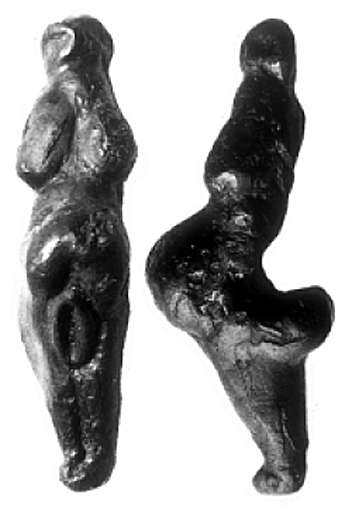
Fig. 33 - Venus of Monpazier, front and profile views.
Photo: MAN
Source: White (2002)
References
- Clottes J., Cérou E., 1970: La statuette féminine de Monpazier (Dordogne), Bulletin de la Société préhistorique française 1970, tome 67, N. 2. pp. 435-444.
- Delporte H., 1959 a:Une nouvelle statuette paléolithique : la Vénus de Tursac, l' Anthrop. t. 63, pp. 233-247.
- Delporte H., 1959 b: La Vénus de Tursac, Bull. Soc. Et. et Rech. Préhist. les Eyzies, n° 9, 7 p.
- Delporte H., 1965: La stylisation des Vénus périgordiennes, In Memoriam do Abade Henri Breuil t. 1, Lisbonne, pp. 237-243.
- Gaudron G., 1956: Note sur la station paléolithique (aurignacien) de Petřkovice près Ostrava en Silésie, Bull. Soc. Préhist. Fr. t. LUI, pp. 50-51.
- White, R. , 2002: Une nouvelle statuette phallo-féminine paléolithique: 'La venus des Milandes' (commune de Castelnaud-la-Chapelle, Dordogne), Paleo N° 14 Décembre 2002 – Pages 177 à 198
